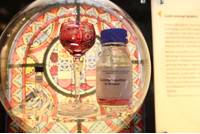The Spintronics and Nanoelectronics group from the Institute of Physics, Academy of Sciences of the Czech Republic has completed another successful research project which opens new oportunities for future information technologies. The work which discovers and explains the origin of a new mechanism that allows to electrically control the velocity of domain walls driven across the magnetic medium was performed within the long term collaboration in spintronics research with groups from Cambridge and Nottingham in the UK. It was published on June 9, 2013 in the journal Nature Materials.
In conventional microelectronics, information is coded in the electron charge whose value is a universal constant. The electron spin, on the other hand, can be viewed as a microscopic compass whose arrow can point in different directions. In magnetic domains walls, which are used in existing technologies for storing information in magnetic media, the spins point to the north pole on one side of the wall and to the south pole on the opposite side. Inside the wall the spin direction gradually rotates. Similar to the electron charge, the domain wall can be in principle used to not only store but also transport, and process information in a microelectronic device. Its complex and variable internal structure, however, allows for new means to realize these functionalities which are unparalleled in the microelectronics based on the fixed electron charge.
The international team has focused on the mobility of domain walls driven by current pulses. The researchers placed their magnetic medium with the domain walls on a piezo-electric transducer and demonstrated that the internal structure of the domain wall is sensitive to the applied piezo-voltage. By piezo-electrically manipulating the domain wall internal structure they achieved 500% variation of the velocity of the domain wall. The experiments have also contributed to a deeper understanding of the microscopic physical mechanisms that allow to move domain walls across the magnetic medium.
For detail information contact Jorg Wunderlich and Tomáš Jungwirth from the Institute of Physics ASCR, Cukrovarnická 10, 162 53 Prague 6, e-mail: wunder@fzu.cz, jungw@fzu.cz
17 Jul 2013


 Česky
Česky













